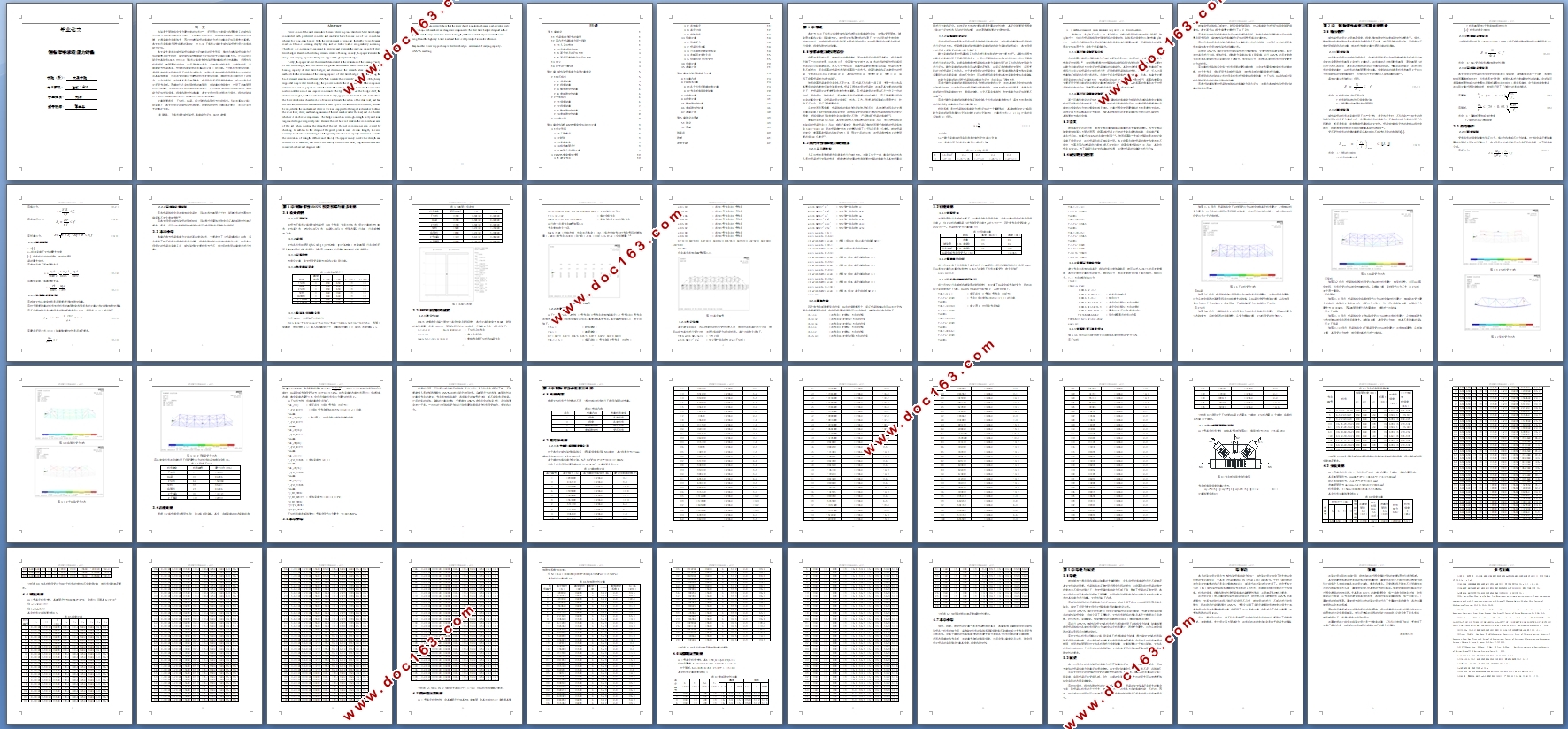钢桁架桥承载能力评估

钢桁架桥承载能力评估(任务书,开题报告,论文15000字)
摘 要
桁架是平面结构中受力最合理的形式之一,采用预应力混凝土和悬臂施工的钢桁架桥已成为大跨度桥梁竞争方案之一。随着经济的发展,我国各种道路的交通流量与日俱增,交通荷载也逐渐加大,因此对钢桁架桥的承载能力进行计算与评估显得愈发重要。本文在已有承载力研究成果的基础上,对6×8下承式公路简支钢桁架桥进行设计与承载能力评估。
本文首先查阅与钢桁架桥承载能力评估相关的研究资料,整理出钢桁架桥承载力评估的背景及研究现状,确定钢桁架桥承载能力评估的研究思路与计算方法。之后运用有限元仿真软件ANSYS对6×8下承式公路简支钢桁架桥整体结构进行仿真模拟,过程包括构件材料、截面属性的确定。之后开始建立节点,连接节点构成单元,并施加约束。荷载类型为桥梁本身、桥面板和铺装层的自重以及公路I级荷载。先对各杆件施加恒载,得到各类杆件在恒载作用下的受力分布特点,并找出各类型杆件中所受最大应力的杆件与其具体数值,之后在受恒载应力最大的杆件处施加活载,得到杆件在荷载作用下的轴力、应力与弯矩,并验算其是否满足要求。桥梁联结系采用高强度螺栓,部分大节点设计采用节点板。因螺栓打孔会削弱杆件的截面积,故验算杆件强度时,使用了净截面面积进行验算。节点板的设计除需满足自身强度外,还应验算节点板的抗撕裂强度。承载能力评估包括强度、刚度和稳定性的验算,本文主要对所有杆件进行强度、刚度的验算,对下弦杆、纵梁和部分竖杆、斜腹杆进行稳定性的验算。
[来源:http://Doc163.com]
计算结果表明,下弦杆、纵梁、部分竖杆和斜腹杆为危险构件。仅在自重和公路I级荷载下,本文所设计的钢桁架桥在强度、刚度和稳定性方面均满足要求,并且还有很大的富足空间。
关键词:下承式简支钢桁架桥、承载能力评估、ANSYS建模
Abstract
Truss is one of the most reasonable forms of stress in plane structures. Steel truss bridges constructed with prestressed concrete and cantilever have become one of the competition schemes for long-span bridges. With the development of economy, the traffic flow of various roads in China is increasing day by day, and the traffic load is also gradually increasing. Therefore, it is increasingly important to calculate and evaluate the carrying capacity of steel truss bridges. Based on the existing research results of bearing capacity, this paper evaluates the design and carrying capacity of 6×8 plain-supported highway truss bridges.
Firstly, this paper reviews the research data related to the evaluation of the bearing capacity of steel truss bridges, and sorts out the background and research status of the evaluation of the bearing capacity of steel truss bridges, and determines the research ideas and calculation methods for the evaluation of the bearing capacity of steel truss bridges. After that, using the finite element simulation software ANSYS to simulate the overall structure of the 6×8 highway-supported simple steel truss bridge, the process includes the determination of the component materials and section properties. After the start of the establishment of the node, the connection node constitutes a unit and imposes constraints. The types of loads are the bridge itself, the deck's own weight, and the road's Class I load. Firstly, apply a constant load to each rod to obtain the force distribution characteristics of various rods under the action of the dead load, and find the rods subjected to the maximum stress in each type of rods and their specific values, and then be subjected to the constant load stress. A live load is applied to the largest rod member to obtain the axial force, stress, and bending moment of the rod member under the load, and it is checked whether it satisfies the requirement. The bridge connection uses high-strength bolts, and some large-node designs use gusset plates. Because the bolt hole will weaken the cross-sectional area of the rod, when checking the strength of the rod, the net cross-sectional area is used for checking. In addition to the design of the gusset plate to meet its own strength, it is also necessary to check the tear strength of the gusset plate. The load capacity assessment includes the calculation of strength, stiffness and stability. This paper mainly checks the strength and stiffness of all members, and checks the stability of the lower chord, longitudinal beams and some vertical bars and diagonal webs. [资料来源:Doc163.com]
The calculation results show that the lower chord, longitudinal beams, partial vertical rods and oblique web members are dangerous components. The steel truss bridges designed in this paper meet the requirements in terms of strength, stiffness and stability only under the self-weight and the highway I-level load, and there is still plenty of room for affluence。
Keywords: lower support simple steel truss bridge;assessment of carrying capacity;ANSYS modeling
[资料来源:http://www.doc163.com]

目录
第1章 绪论 1
1.1桥梁承载力研究的背景 1
1.2国内外桥梁承载力研究现状 1
1.2.1 人工巡检法 1
1.2.2 荷载试验评定法 2
1.2.3基于规范的评估方法 3
1.2.4基于可靠性理论的评估方法 3
1.3意义 3
1.4研究的主要内容 3
第2章 钢桁架桥承载力实用计算理论 5
2.1 轴压构件 5
2.1.1强度验算 5
2.1.2刚度验算 5
2.1.3整体稳定性验算 6
2.1.4局部稳定性验算 6
2.2 受弯构件 6
2.2.1 强度验算 6 [资料来源:http://Doc163.com]
2.2.2 刚度验算 7
2.2.3整体稳定性验算 7
2.2.4 局部稳定性验算 8
2.3 本章小结 8
第3章 钢桁架桥ANSYS模型模拟与初步计算 9
3.1 设计资料 9
3.1.1 工程概况 9
3.1.2 材料 9
3.1.3 荷载类型 9
3.1.4 构件截面尺寸 9
3.1.5截面几何参数计算 9
3.2 ANSYS模型模拟过程 10
3.2.1建立节点 10
3.2.2连接单元 11
3.2.3单元分组 12
3.2.4添加约束 13
3.3恒载计算 14
3.3.1恒载受力 14
3.3.2桥梁杆件自重 14
3.3.3行车道板和铺装层加荷 14
3.3.4求解后处理命令流 15
3.3.5恒载作用下杆件受力 15
3.4活载计算 20
[资料来源:Doc163.com]
3.5本章小结 21
第4章 钢桁架桥承载能力计算 23
4.1 计算内容 23
4.2 联结系计算 23
4.2.1 各个杆件所需螺栓数计算 23
4.2.2 节点板撕裂强度验算 28
4.3 强度计算 29
4.4 刚度计算 31
4.5整体稳定性计算 34
4.6局部稳定性计算 36
4.7本章小结 38
第5章 结论与展望 39
5.1结论 39
5.2展望 39
结束语 40
致谢 41
参考文献 42 [资料来源:Doc163.com]
